The Best Toaster Ovens Under $250, According to Our Tests
Dotdash Meredith and Yahoo Inc. may earn commission or revenue on some items through the links below.
Our top pick is the Breville Smart Oven.
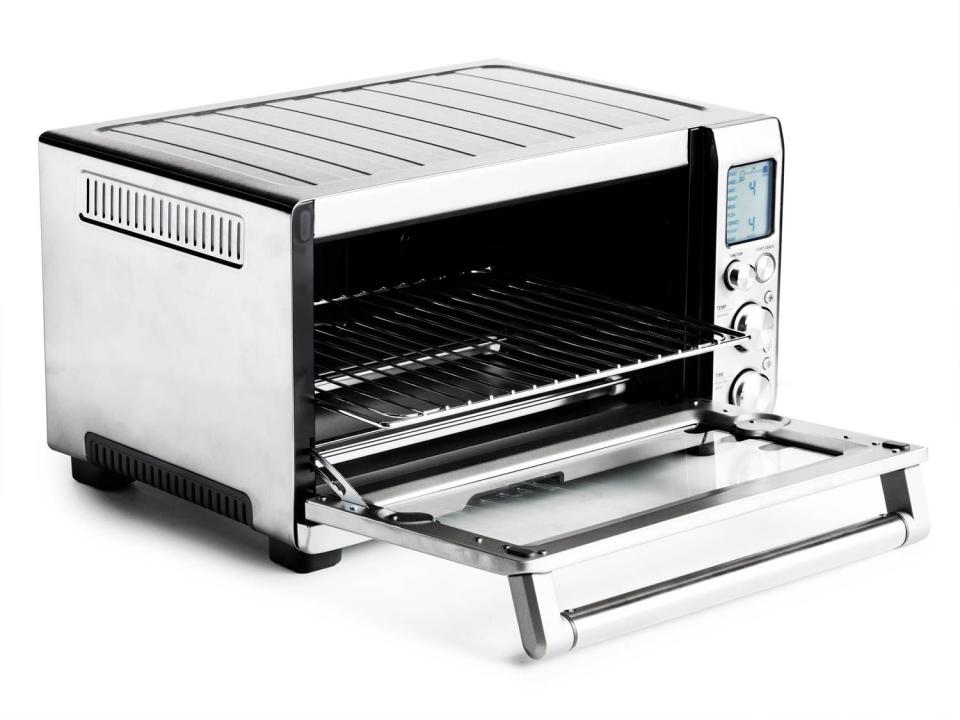
Our favorite toaster oven is the Breville Smart Oven. Since we initially tested it, the price has jumped up a little, but this model performs consistently and is incredibly easy to use. We also like the Panasonic Flash XPress, which is our top pick if you're in the market for a smaller toaster oven.
With countertop space at a premium in most kitchens, why commit to a toaster oven when your full-size version bakes and broils and a small pop-up toaster can handle morning English muffins? Well, for starters, a smaller toaster oven preheats faster and uses less energy than a traditional oven. Think about it: Heating up a full-size oven to warm through a slice of pizza or broil a couple of salmon steaks seems like overkill. Plus, firing up a traditional oven can make a kitchen uncomfortably hot in the summer. Beyond handling your daily bread, a toaster oven can quickly reheat and cook small meals, without turning things into a big to-do. If you have the counter space, it's worth owning one.
Our goal here was to find a capable toaster oven that was well built, accurate, easy to use, and agile enough to complete a variety of tasks, including toasting, roasting, baking, and broiling. We tested 12 models, ranging from about $100 to $250 (what we felt to be a reasonable price cap for a toaster oven), to find ones that performed well across a range of common cooking tasks.
We recently tested a handful of other toaster ovens (from Black+Decker, Cuisinart, and Oster) at our Lab. Our top picks have not changed and you can find our thoughts on each of these four additions towards the bottom of this page.
The Winners, at a Glance
Breville BOV800XL Smart Oven
The Best Toaster Oven

The Breville Smart Oven performs consistently and is very intuitive to use. It scored high marks in each round of testing, producing one of the better pieces of toast, baking frozen pizza to yield melted cheese on top and crispy crust below, cooking a frozen chicken pot pie, and baking perfect cookies. The styling is handsome, and the bright LCD screen is easy to navigate with just a few dials and buttons.
Panasonic NB-G110P FlashXpress Compact Toaster Oven
The Best Small Toaster Oven

Panasonic's Flash Xpress bested a lot of larger, more expensive toaster ovens. It uniformly toasts and bakes—but only if you position the food correctly on the rack. The '80s look, which has that color-TV-and-VCR-combo vibe, isn't for everyone, but the dashboard is easy to navigate without referring to the owner's manual.
The Criteria: What To Look for in a Great Toaster Oven
A toaster oven isn't worth much if it can't handle its most basic of tasks: toasting bread. Assuming it can do that well (and let's be clear—not all can), it should also meet the essential requirements we'd expect of any oven. It should be true to temp and heat evenly, making it a realistic alternative to a full-size oven when reheating and cooking smaller portions of food. Additional settings, like convection and broiling, are a plus, though not absolutely necessary.
Read More:We Tested 14 Toasters—Here Are Our Favorites for Bagels, Oblong Slices, and More
Our ideal toaster oven is also easy to use. No one should have to break out the user's manual just to figure out how to make toast or bake a few cookies. We also looked at rack design, interior lighting, oven shape (which varied widely), and cord length. The toaster ovens we tested ranged from a one-foot cube to a model that was more than two feet wide with its French doors open. Mind you, the space a toaster oven takes up isn't limited to the size of the machine itself: All manufacturers require four to six inches of clearance around the oven for safety reasons. That quickly eats up a lot of precious counter real estate.
In our search for models to test, we cross-referenced reviews on Amazon, America's Test Kitchen (subscription required), and The Wirecutter.
A Note About Convection
Toaster ovens in the $100–250 price range usually include a convection feature. As with a full-size oven, the convection mode on a toaster oven spins a built-in fan, circulating hot air around the food while speeding up cooking. In toaster ovens, the fan is usually mounted behind the control panel, pushing hot air across the food. However, one model we tested, the Cuisinart, mounts the fan on the ceiling, forcing the air down over the food. Our testing revealed that this innovative design wasn't enough to overcome inaccurate temperatures.
Our tests also proved that not all convection is created equal: With the fans running, some ovens browned more consistently than others. Should you buy a toaster oven because of the convection marketing hype printed on the box? Convection makes a lot of sense in a full-size oven, where hotter and colder pockets of air are common, but in a smaller toaster oven, the benefits aren't as noticeable. Our winning Panasonic, which doesn't offer a convection fan, browned well and was one of the speedier toaster ovens we tested. Cuisinart's convection setting accelerated some cooking tasks, but the oven also ran hot, burning the cookies we tested (though the effect was less severe when convection was turned off). That model aside, a convection feature won't harm your food, but it's not a game-changer in such a small cooking appliance.
The Testing
Test 1: Toasting Bread
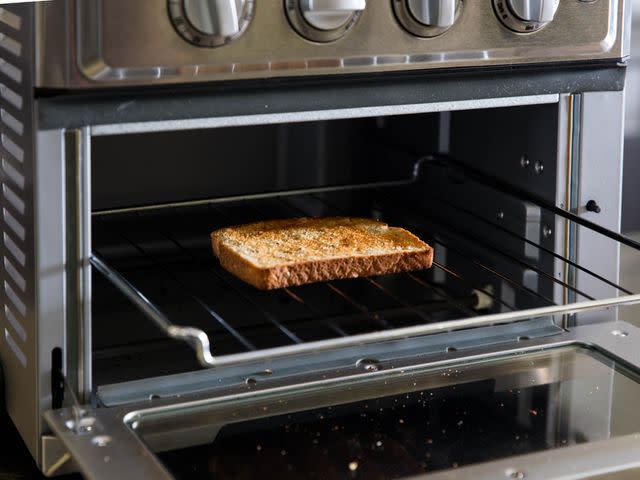
Serious Eats / Vicky Wasik
We set each machine to medium-dark, then toasted a slice of bread to see how consistent the color was.We tested how quickly and evenly each oven was able to toast white sandwich bread, and how true the results were to the selected doneness setting. To do this, we centered a single piece of bread on the rack and used the medium-dark setting on its toasting mode. This meant that each toaster was allowed to run its own protocol in terms of temperature and time to achieve the doneness goal.
The results varied considerably on all fronts. One toaster oven almost burned the toast after running for five minutes, while another left faint, inconsistent coloring after nearly the same amount of time. Five minutes was about the average time for most of the ovens to run their medium-dark setting, with the speedy little Panasonic the fastest, finishing its job in just two minutes. Some models were able to toast a slice's top and bottom sides to a similarly even hue, while others served up pieces that were golden on top and pale on the bottom, like a sunbather who falls asleep on the beach and wakes up with a deep tan on half their body.
Test 2: Finding Hot and Cold Spots
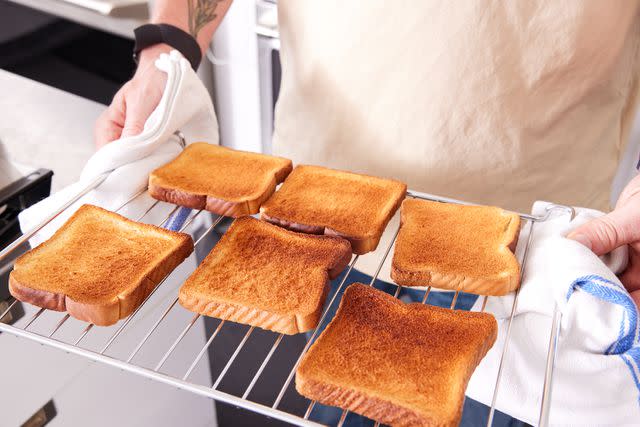
Serious Eats / Will Dickey
To find each toaster oven's hot and cold spots, we covered the racks with white sandwich bread, cutting the pieces to fit them edge to edge. To level the playing field for this test, we decided against using each oven's toast doneness presets (as we'd already observed how widely their medium-dark settings varied) and instead preheated each oven to bake at 350°F (180°C), without convection on models that gave us the option. We ran each oven for 10 minutes.
In most of the ovens, the centermost slice of bread browned fairly evenly, but the bread tended to get paler the closer it was to the walls. The Panasonic, which we set to 355°F (the closest we could get to 350°F using its controls), achieved the most even browning, save for a pale band nearest the oven door. It's worth remembering, though, that it's also the smallest oven of the group, with only enough space for about four slices of bread. The Breville, like a few other models, developed good color on the center column of bread (we fit nine slices total), with less consistent browning near the oven walls. The poorest-performing models barely browned the bread at all, or didn't apply the heat evenly above and below the slices.
Test 3: Baking
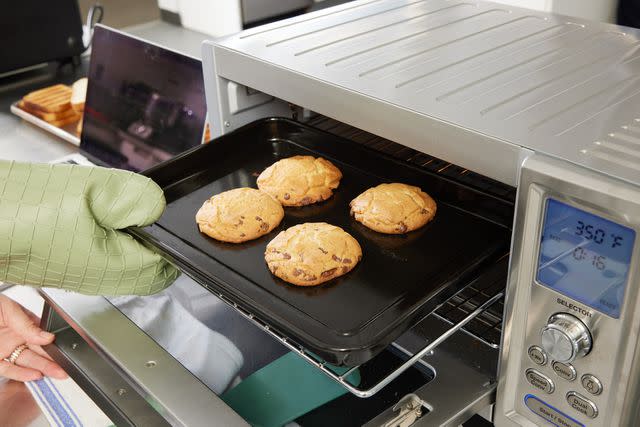
Serious Eats / Will Dickey
Baking Frozen Pizza
Turning supermarket pizza from an icy Frisbee into a tasty snack is harder than it sounds. To test how well each toaster oven crisped the crust from below, while melting the cheese and sauce from above, we baked a seven-inch round frozen pizza on each machine's included sheet pan. We let each oven preheat for five minutes at 400°F (200°C)—without convection, if we had the option—and cooked the pies for the 14 minutes called for on the packaging.
The Breville developed a crispy crust from the edge of the pie to nearly the center, while lesser ovens left a bigger section of soft, floppy crust in the middle. It also uniformly melted the cheese. The Panasonic, cooking at 390°F (the closest we could get to the pizza box's recommended 400°F), delivered a very crispy crust, though the cheese and sauce seemed hotter than on any other pie—as evidenced by the shredded, raw state of the roofs of our mouths after we bit into it. Some models failed to uniformly melt the cheese after 14 minutes.
Baking Frozen Pot Pie
We repeated the baking test with a more three-dimensional piece of food than flat, thin pizza: a frozen pot pie. The goal here was to properly brown the crust in the same time it took to heat the filling through to the center, following the cooking instructions on the packaging.
Results ranged from pies with unevenly browned pastry crusts to ones that looked done on the outside but were still cold within. The Breville's pot pie came out with a nicely browned and crispy crust and was hot throughout in just the time stated on the packaging. The Panasonic cooked the pie three minutes faster, but had less consistent coloring on the pie shell.
Baking Cookies
When you're itching for cookies, a toaster oven can bake a small batch from start to finish in the time it takes a larger oven to preheat. To see which models could deliver craving-squelching cookies, we cooked preportioned dough on each model's baking sheet.
The good news is, given some attention to cooking time, many models delivered consistently browned cookies that spread evenly and had crispy edges and chewy centers. The Breville's cookie preset automatically bakes at 350°F for 11 minutes, which just happened to be the exact requirements in the cookie dough's baking instructions, and turns out evenly browned cookies. The Panasonic, which has only a 355°F setting, browned the cookies faster than average (we pulled them after 11 minutes), but left less brown color on the cookies closest to the door. The pan that came with the Panasonic also left noticeable ridges on the bottoms of the cookies.
Test 4: Broiling
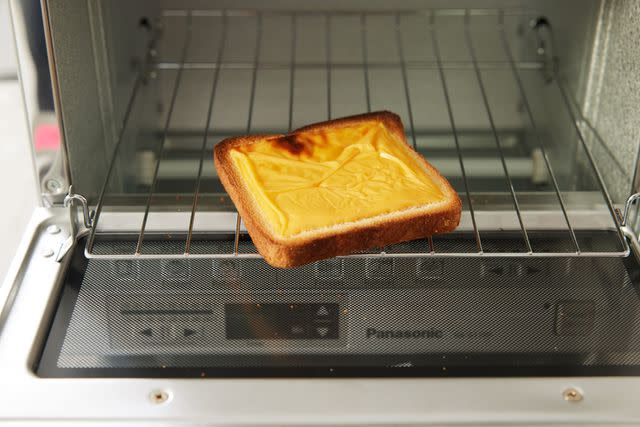
Serious Eats / Will Dickey
While not all toasters have a broiling function, we wanted to test the intensity of the broiler on those that do. (We also tested any oven without a broiler function at its hottest setting, just to see how it competed.) To do that, we put a slice of classic Kraft American cheese on bread and broiled it, timing how long it took for the cheese to become a uniformly melty mass.
All the ovens did eventually melt the cheese, but the largest model in our test took more than seven minutes to do it. Curious to see if the position of the rack played a big part, we measured the distance between the rack and the top heating elements on each oven and found a range of space between one and a half and four and three-quarters inches. (For any oven with an adjustable rack height, we set the rack to the broiler position, which was usually the highest one, nearest the top heating elements.) As it turned out, proximity to the heating elements isn't a good sole predictor of broiling success; some of the models with racks closest to the broilers were slow to melt the cheese. Just as important was the heat intensity of the elements themselves.
The Breville's broiler has three temperature settings, ranging from 300°F (150°C) to 500°F (260°C). When set to the highest one, it melted the cheese in just over two minutes, despite the fact that the rack was two and a quarter inches away from the heat. The Panasonic, which doesn't have a broiling option (we heated it to 500°F, the oven's highest temperature), melted the cheese in about 75 seconds, yet the rack is more than three and a half inches away from the elements.
Test 5: Temperature Consistency
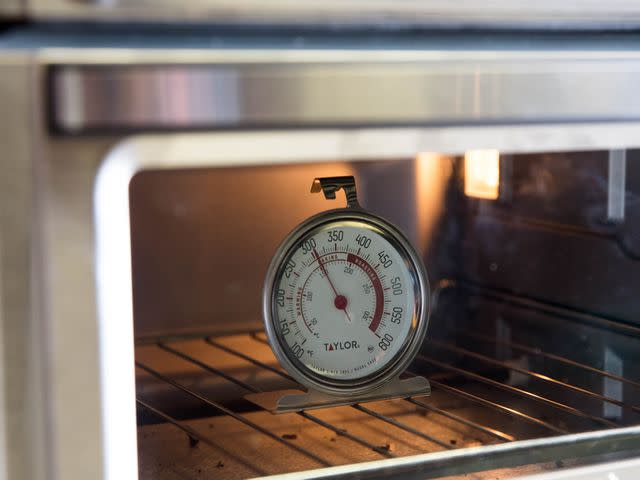
Serious Eats / Vicky Wasik
We used an oven thermometer to chart how closely the top three toaster ovens held to their target temperatures.After putting these toaster ovens through the above rounds of testing, we narrowed the field to three finalists: the Breville, the Panasonic, and the Cuisinart. To see how the temperature fluctuated in each model, we ran them for 10 minutes on low, medium, and high heat, charting the temps using an oven thermometer. (The Cuisinart had been consistently overcooking everything, but we were curious to dig a little deeper into why, which is how it ended up in this test.)
On its lowest setting, of 120°F (50°C), the Breville reached 120°F and never fell below that mark, though it did rise to between 130 and 135°F (55 and 57°C) for a few minutes before settling back down to just over the target temp. The Panasonic's lowest temp is quite a bit higher, at 250°F (120°C); once it hit that mark, it never fell below it and held steady at 255°F (125°C). By comparison, the Cuisinart's "warm" setting, which the company reports is around 180°F (80°C), reached around 250°F before falling down to 195°F (90°C) and then to 170°F (75°C). In the end, we concluded that the Cuisinart has a lot of power, but runs too hot.
How We Chose Our Winners
Through our tests, it became clear that many toaster ovens aren't up to the task of being good toasters or good ovens. The Breville, our top pick, performed well on all the tests, but it was also the most expensive model we evaluated. The Panasonic is a solid choice for home cooks who value speed or a smaller size, and was a bit less expensive.
Breville BOV800XL Smart Oven
The Best Toaster Oven

What we liked: The Breville Smart Oven moderates oven temperatures fairly accurately, keeping the interior within 15 degrees of the target. The LCD screen is bright and clear, and the oven is easy to operate using the control panel's dials and buttons. The build feels solid, with knobs that turn smoothly, a crumb tray that didn't warp, and a rack that auto-ejects using magnets on the door, partially pulling out your food for easier access and lower risk of hand burns (when the rack is in the middle position).
The Breville is one of the few models we tested that includes modes for baking and roasting, and you have the option to use either one with or without convection. We asked Breville what the difference is, and it has to do with the intensity of the heating elements. In bake mode, the oven uses close to 1,500 watts from four elements; in roast mode, it maxes the power draw to about 1,800 watts, for a more intense blast of heat.
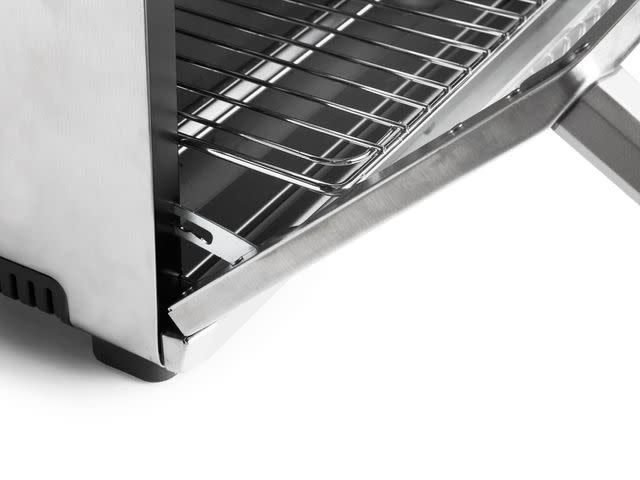
Serious Eats / Emily Dryden
When you open the Breville's door, a built-in magnet partially pulls out the cooking rack for easier access.What we didn't like: The Breville, the most expensive model in our test, has seven shade settings for toast—but no interior light to help you see how the toast is coming along. Some testers noted that because the LCD screen stays on for more than five minutes after the oven shuts off, it can trick you into thinking the appliance is still cooking.
Price at time of publish: $270.
Key Specs
Temperature range: 120°F to 450°F
Preset functions: Toast, bagel, bake, roast, broil, pizza, cookies, reheat, and warm
Dimensions: 18 1/2 inches x 16 1/4 inches x 11 1/4 inches
Accessories: 12 x 12 inch enamel baking pan; 12 x 12 inch enamel boil rack; 13-inch nonstick pizza pan
Capacity: 6 slices of toast; 13-inch pizza
Wattage: 1800 watts
Warranty: 1-year limited
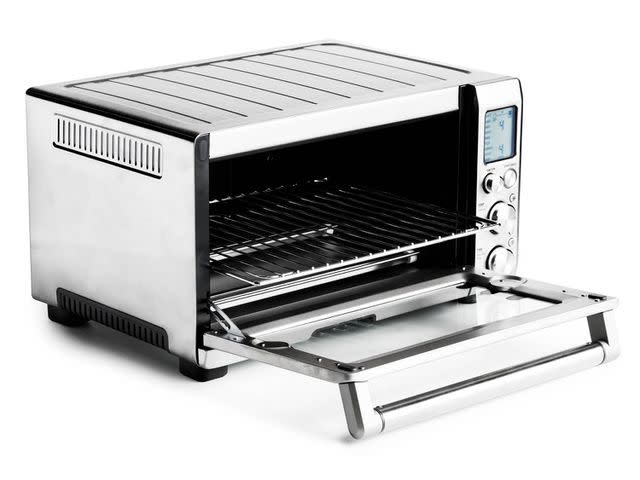
Serious Eats / Emily Dryden
Panasonic NB-G110P FlashXpress Compact Toaster Oven
The Best Small Toaster Oven

What we liked: The Panasonic Flash Xpress cooked evenly and quickly across most of our tests, stumbling a bit only when it came to browning the crust on chicken pot pie. It turned bread into golden satisfaction in two minutes flat, the fastest of the models we tested. The trick is to push the toast toward the back of the rack, as we found that food left near the door browned less well. Despite the small size—the Panasonic is about 12 inches in every direction—and budget price ($117 at the time of testing), this toaster oven beat out a lot of bigger, more expensive machines that boasted a convection feature.
The key to Panasonic's performance is the heating elements. Most of the toaster ovens in our test use quartz elements to generate far infrared heat, which cooks the outer layer with a larger wavelength (around three micrometers) that can't penetrate food as deeply. While the Panasonic has two of those, one above and one below the rack, it also includes one near infrared halogen element on top, with a shorter wavelength (one micrometer) that penetrates the food more deeply. The halogen element speeds up cooking and also functions as the interior light. But faster cooking can be tricky if you habitually follow the times listed on frozen-food packaging, as those are often based on conventional oven performance.
You'll either love or hate the Panasonic's styling, which looks like it's straight out of an episode of Stranger Things. The dashboard is easy to use, but has some quirks. There is no broil function—instead, you crank the oven to the highest toast setting—but, oddly, there is a preset specifically for frozen hash browns. As it's designed in Japan, the adjustable temperature scale is built around common Celsius temperatures, not Fahrenheit numbers, though Fahrenheit temps are listed. That explains why you get 355°F instead of the more common 350°F, and 460°F when you might want 450°F. Will that ruin your food? Probably not, but it does require a little more babysitting when you're working outside of the presets.
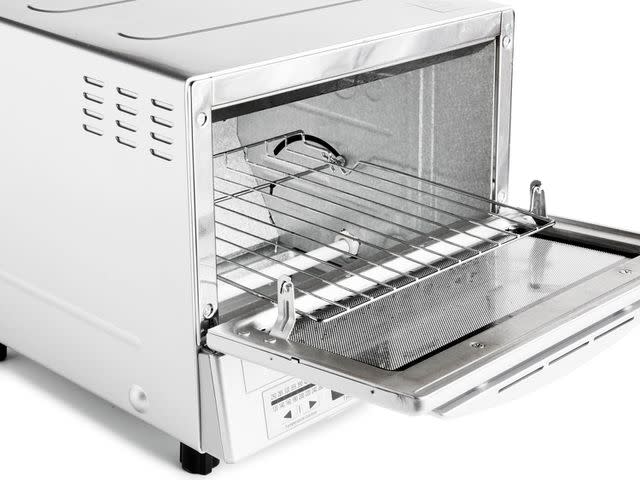
Serious Eats / Emily Dryden
While the Panasonic's rack pulls out when you open the door, removing it for cleaning could be easier.What we didn't like: While the Panasonic is cooking, its bright halogen element cycles on and off, which can be distracting (and maybe a little creepy, in a sci-fi sort of way). The timer maxes out at 25 minutes, meaning if you want to use the timer for longer, you have to keep adding time. The crumb tray is flimsy and warps after a few uses. While the rack partially pulls out when you open the door, removing the rack for cleaning is difficult. Even heating near the door can be an issue: Any food placed close to it tends to undercook compared to the portions deeper inside the oven, so make sure to push your food in as far as it can go to minimize this effect.
Price at time of publish: $170.
Key Specs
Temperature range: 250°F to 500°F
Preset functions: Toast, frozen pizza, frozen waffles, frozen hash browns, reheat rolls, quick reheat
Dimensions: 14.5 inches x 13.5 inches x 13.7 5 inches
Accessories: 9-inch square baking tray
Capacity: 4 slices of toast; 9-inch pizza
Wattage: 1300 watts
Warranty: 1-year
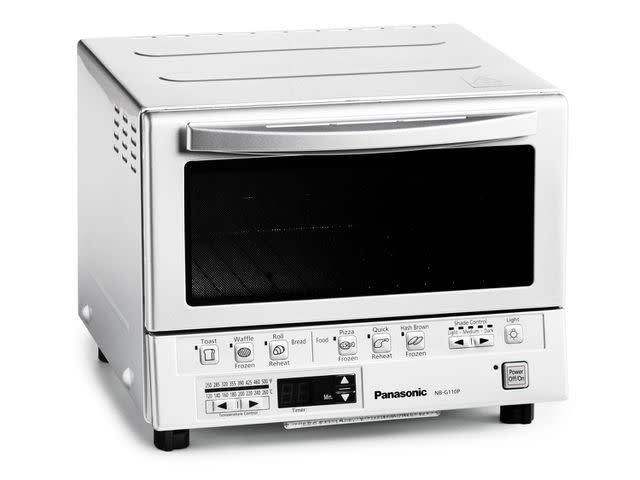
Serious Eats / Emily Dryden
The Competition
DeLonghi Livenza Countertop Oven: The DeLonghi has six toast shade settings, but overcooked the edges of the bread when we aimed for medium brown. The heaviest model we tested, at just under 25 pounds, this was one of the few to include a rubber gasket around the door to trap heat. But the racks rub up against it, which could lead to premature failure. This toaster oven did a decent job of cooking pizza, but the convection setting left an inconsistently browned pot pie crust. The knobs also felt cheap.
KitchenAid Compact Countertop Oven: The analog KitchenAid produced inconsistent coloring on the top side of the toast, and struggled to cook the underside of the bread to the same shade. Frozen pizza and chicken pot pie emerged from the convection bake mode unevenly browned. After preheating and 11 minutes of baking, chocolate chip cookies came out of the oven slightly underdone in the center.
Oster Manual French Door Oven: The mammoth Oster, which is a few inches smaller than a piece of carry-on luggage, didn't produce consistent toast, and barely browned the bread during our test of hot and cold spots. The French-style doors provide great access, but they also hog space—this appliance needs almost two feet of horizontal countertop clearance for the doors to fully open. The cord length, at 26 inches, was the second shortest of the models tested, which makes it even harder to find the right spot for this oven.
Cuisinart Toaster Oven: Powerful but plagued by too-hot temps, the Cuisinart has a unique ceiling-mounted convection fan that seemed only to exacerbate the oven's browning problems. We like the gasket behind the door, the bright interior light, and the switch that shuts the oven off when you reach in, but not enough to offset the performance concerns. You can get good results with this oven—it turned out a good pot pie in the shortest amount of time, only 50 minutes—but it requires a lot of supervision, given how hot it runs. If we had followed the timing directions on the box, the pot pie would likely have burned. That's more attention than we'd care to spare for morning toast. The Cuisinart also burned cookies, blasting them with hot air so they domed instead of spreading.
Krups Stainless Steel Deluxe Convection Toaster Oven: The Krups is affordably priced ($107 at the time of testing), and it's an attractive option. As with a lot of ovens, the door on the Krups has no spring mechanism to prevent the door from dropping when opened, meaning it can slam down on your countertop if you let it. This model, set to medium, made slightly darker toast than what we expected, but it was consistently colored edge to edge. We can't say the same for the pizza, which had cheese that was burned in some spots and undercooked in others. The Krups did a nice job on chicken pot pie, with a uniformly brown crust, but it overcooked the cookies.
Hamilton Beach Digital Countertop Toaster Oven: At under $100 (at the time of testing), the Hamilton Beach would be an attractive replacement for a traditional toaster, but it struggled at this basic function. It overcooked the edges of the bread and left a pale band running horizontally through the center—and things didn't look much better underneath. It also undercooked frozen pizza (even after 14 long minutes), and was tied for the second slowest to bring chicken pot pies up to temp.
Black+Decker 4-Slice Toaster Oven: This toaster oven spiked to extremely high temperatures during preheating before leveling out to the set temperatures, making it less predictable than our top picks.
Cuisinart Chef’s Convection Toaster Oven: This model cooked unevenly, consistently producing too-browned toast.
Black+Decker Convection Toaster Oven: This model struggled to reach its set temperatures.
Oster Toaster Oven / Digital Convection Oven: Inaccurate settings left every slice of toast too pale or dark, and it never was able to reach its preset oven temperatures.
FAQs
Should I buy a toaster oven or a toaster?
This really comes down to your budget and available counter space. A toaster oven is certainly the more versatile appliance, but if you’re working with limited room—or if you truly only need to toast bread—there’s nothing wrong with a pop-up toaster. Our top pick, however, is able to bake cookies, roast potatoes, make frozen pizzas, and more—it's truly like having a second oven.
Can I air-fry in a toaster oven?
Proper air fryer aficionados will likely disagree, but you can air fry in some toaster ovens. Convection toaster ovens have a fan (perhaps more than one) to rapidly circulate hot air, which is ultimately the same function as an air fryer. Since air fryers often have a smaller capacity than toaster ovens, they might heat up faster and “fry” your food more quickly and do offer some other advantages, which you can read about here.
What are the disadvantages of a toaster oven?
The biggest downside of a toaster oven is its size. Though faster and more efficient to use versus firing up your regular oven, toaster ovens require precious countertop real estate. This can be difficult to argue in favor of, especially if you already have an air fryer or if your standard oven has convection functionality. At the same time, toaster ovens tend to be more temperature accurate that full size appliances, and consume much less energy, so there are always trade-offs.
Is it worth getting a toaster oven?
If you're looking for an appliance that'll toast and act as a mini-oven (for roasting, baking, and broiling), then a toaster oven is likely worth it. Because they heat up so quickly and use less energy than a full oven, they're extremely handy for weeknight meals. If you're a household of one or two people you might find yourself using your toaster oven as your main oven most nights, like a few Serious Eats staffers. They're also great for people who like to prep larger meals and need more cooking space.
Can you use a toaster oven like a regular oven?
That mostly depends—not every toaster oven is made the same. Our top pick, the Breville Smart Oven, is designed to function like a miniature convection oven complete with multiple heating settings and modes. Many Serious Eats staffers use this toaster oven for smaller meals, baking cookies, roasting vegetables, or any other scaled-down task a regular oven can perform. Not every toaster oven is designed for this kind of use, however.
Read More:Balmuda: Our Review of the Pretty, Steam-Powered Toaster

